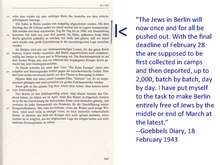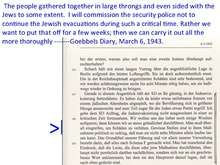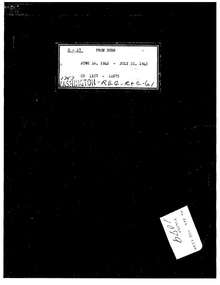Rosenstrasse protest

The Rosenstrasse protest was a collective street protest on Rosenstraße ("Rose street") in Berlin during February and March 1943. It was initiated and sustained by the non-Jewish ("Aryan") wives and relatives of Jewish men who had been arrested for deportation. The protests by these intermarried German women continued until the men were released. It was the only continuous street demonstration by Germans against the deportation of the Jews.
Events
There is a dispute about the key context of events for understanding the regime’s response to the Rosenstrasse Protest. What happened, and how did the regime perceive the protest?
Most historians have understood the protest as part of the history of intermarriages. The Nazi dictatorship wanted to murder these Jews along with all the other German Jews it had identified under the 1935 Nuremberg Laws as “full Jews.” Most “Aryans” married to Jews, however, refused to divorce. In a succession of actions beginning already in 1933, they placed themselves between the regime and its mission to destroy their marriages so that their Jewish family members could be socially isolated and persecuted. Of course, the dictatorship could have achieved its will at any point by using force. But it refrained due to its overall goals. It did not want to draw attention to intermarried couples and their examples of noncompliance, possibly inciting scenes that would perhaps “sacrifice the secrecy” of the Final Solution (there were some 30,000 of these intermarried couples in Germany as of 1939). As these Germans refused the dictatorship’s incentives and intimidations, the regime began to make exceptions for intermarried Jews while also increasing measures of intimidation to persuade their intermarried Aryan partners to divorce. The exceptionally brutal arrests of Berlin Jews, beginning on February 27, 1943 represented an escalated effort to intimidate these Aryans into allowing the dictatorship to have its way with their Jewish family members. When the women refused, signaling that they were prepared to die in order to show their Jewish family members that they cared, the regime again backed down, once again temporarily exempting them from deportation.
Recently, German historians have placed the protest in a variety of other contexts, including that of Communist and Socialist resistance, Jewish survival in the underground, or Nazi forced labor and deportation policies. Wolf Gruner has argued that at this time, the Gestapo’s resolve to clear the German Reich of the last Jews living there did not include Jews marrried to Aryans. It did not plan to deport any intermarried German Jews in early 1943, and it corrected Berlin officials who violated this intention. In Gruner’s view the protest had no impact on the Gestapo because the Gestapo never planned to deport any intermarried Jews at this time. German historian Diane Schulle summarizes this perspective in an essay titled “Forced Labor”: “The Gestapo decree recently brought to light by historian Wolf Gruner … suggests that regardless of the protests, the deportatoin of mixed-marriage partners had never been part of the plan. The arrests of Mischlinge [“half-Jews”] and Jews living in mixed marriages had been undertaken for a purpose other than deportation: registration.” [1]).

Citing Goebbels diary, Gruner agrees that in early 1943 Goebbels and Hitler were determined to conclude the “Jewish Question” in Germany and above all in Berlin, "as fast as possible (schnellstmdglich)." Hitler ordered Nazi Party leaders "to be ruthless [. . .] toward Jews,” writes Gruner, but Nazi directives at that time prohibited the Gestapo from deporting German Jews married to non-Jews. It is also clear that on February 20, 1943, Himmler’s Reich Security Main Office (RSHA) ordered that intermarried Jews were to be exempted from the deportations—but only “temporarily” as the decree stated. Four days later a Gestapo order from the city of Frankfurt/Oder directed Gestapo agents to avoid drawing attention to intermarried Jews, while encouraging them to arrest these Jews on various charges, including “impudence,” prior to sending them to a “concentration camp.” According to this order, “much would depend on the arbitrary behavior of the officers at each location,” Gruner wrote. “The officials had received a ‘carte blanche’ to penalize ‘impudent behavior’ from ‘protected’ Jews by taking them into protective custody; however, the officials were also told not to overstep their authority.”

There are important issues at stake in the “historians’ controversy” about this protest. In 2003 German historian Kurt Pätzold explained part of what is at issue: arguing that a protest rescued Jewish lives, “strikes at the center of the historical perception of the character of the Nazi regime and the way it functioned, and weighs on judgments about the possibilities for resistance.” Another German historian, Konrad Kwiet, added that “the successful There are points of agreement among historians despite the “heated debate” about how to interpret the Rosenstrasse events “after the release of Margaretta von Trotta’s film Rosenstrasse.”outcome of this late protest suggests that if similar actions at an earlier stage had been carried out throughout Germany, they might have halted the increasingly destructive course of the German anti-Jewish policy.” Also at stake is whether the Gestapo always destroyed opposition as soon as they knew about it. Did the regime set its course, issue orders, and carry them out in every detail, using brute force to have its way if necessary? Or was it tactically opportunistic, improvising its decisions within changing circumstances to maximize its impact? Ultimately, the question is whether the Jews released following the Rosenstrasse demonstration owe their lives to the protest. Or whether as another German historian wrote, they have the Gestapo “to thank” for their survival.
In February 1943, Adolf Hitler ordered Fritz Sauckel to take half-million workers from France to work as slaves in Germany.[2] One result of the expected inflow of French workers into German factories was that the German Jews in mixed marriages who had been working in German factories were now deemed redundant and Joseph Goebbels, the Gauleiter of Berlin ordered the "factory Jews" that had been protected so far to be deported to the death camps.[3] On 18 February 1943, Goebbels proclaimed a policy of "Total War" in a speech in Berlin, and now argued to avoid a "stab-in-the-back" that had been alleged to have caused Germany's defeat in 1918 required the "internal security" situation of the Reich be improved.[4] At a meeting, Hitler and Goebbels agreed that there "could be no internal security" until the last Jews living in Vienna and Berlin could be deported "as quickly as possible".[5] For the Nazi leadership, it was the November Revolution of 1918 that had caused Germany's defeat in World War I, not defeat on the battlefield as supposedly Germany was on the verge of victory in 1918 when the "stab-in-the-back" in the form of the November Revolution took place.
Just after the German defeat in the Battle of Stalingrad, the Gestapo had arrested the last of the Jews in Berlin during the Fabrikaktion. Around 1,800 Jewish men, almost all of them married to non-Jewish women (others being the so-called Geltungsjuden), were separated from the other 6,000 of the arrested, and housed temporarily at Rosenstraße 2–4, a welfare office for the Jewish community located in central Berlin. On the morning of Saturday February 27, 1943, the SS, the Gestapo and the Berlin police began to arrest Jews all over Berlin. The 1,800 men were so-called "privileged Jews", a category exempt from deportation and other anti-Jewish measures by reason of being married to German spouses or employment as officials of the Reichsvereinigung der Juden in Deutschland, the Jewish organization officially recognised by the German government for the purpose of controlling the Jewish population.
Despite the media blackout ordered by Goebbels, it was not impossible for the state to arrest 5, 000 Jews in Berlin in one day without people noticing. All over Berlin on 27 February and 1 March 1943, trucks packed full of Jews were constantly going up and down the streets of Berlin, and, as one Jew remembered, most people preferred to look the other way or else they clapped their hands in approval.All throughout March 1, more and more trucks had arrived at Rosenstrasse 2-4 to pack more and more people into the center. The people arriving at Rosenstrasse were mostly Jewish men married to Aryan women or Mischlinge. So many people were being jammed into the building that in one room people had to stand and take turns sitting down.
By this point, several of the hundreds of women gathered outside of Rosenstrasse 2-4 had announced that they would not leave until their husbands had been released. A jeep drove up with four men from the 1st Waffen SS Division Adolf Hitler Leibstandarte to tell the women to go home, but they were ignored. The authorities were astonished by the protests as it had never occurred to them that this was possible, and the SS guards at the Rosenstrasse 2-4 felt it necessary to call upon the Berlin police to provide reinforcements as the crowds outside of Rosenstrasse 2-4 kept getting larger and larger.
The protests were briefly stopped on the night of 1 March 1943 when the British Royal Air Force (RAF) bombed Berlin, causing everyone to take shelter. The Luftwaffe was founded on 1 March 1935, and 1 March was a public holiday in Germany, the Day of the Luftwaffe, which the RAF decided to honor with an especially big air raid on Berlin. Those held inside of the Rosenstrasse recalled the cowardice of the SS and Gestapo, who were the first to take to the cellars of the building to escape the bombing as soon as the air raid siren blew. Braun recalled mixed feelings about the bombing of Berlin: "On the one hand were fury and hate against the Nazis, who deserved the attack, and on the other side there was terrible misery all around each of us-the screaming people, the hellish fires". One Jewish woman, Charlotte Isreal, stated: "I always had such fear about the air raids. But on that night I thought, that serves them right! I was so enraged. I was together with a few other, who got down on their knees and prayed. I could have laughed in scorn! But then I thought of my husband, who as locked up at Rosenstrasse. I knew they would not be able to leave the building." Sometimes, people passing by joined the protests.[6]
On 2 March 1943, Berlin newspapers all carried violent denunciations of the British "terror attack" that had killed about 600 people and destroyed much of downtown Berlin. In Der Angriff, an editorial by Goebbels called the British bombing a test of the volksgemeinschaft, stating the interests of the volksgemeinschaft outweighed the interests of the individual and called upon people to help each other while blaming the Jews of Berlin for the bombing. Goebbels was with Hitler at Obersalzburg and did not return to Berlin until 3 March, when he first learned of the Rosenstrasse protests. Initially, the authorities expected the protests to stop after the bombing, and were stunned when the crowds of women grew larger instead. Alfred Schneider, the SS man in charge of Rosenstrasse 2-4, appeared outside of the center several times in his full black SS uniform, ordered the women home and was forced to beat a retreat when the women stayed put, with several of the women calling him a "pencil, this nobody who wants to be somebody" (a reference to his thin frame and his well-known pomposity). Several times, the SS and the Berlin police aimed their guns at the women and shouted "clear the streets or we'll shoot!". The women outside held their ground and were not shot.

By 4 March 1943, the regime felt threatened enough by the protests at Rosenstrasse to lash out by executing the last members of the Communist Herbert Baum resistance group who had burned down a Nazi art exhibit in Berlin in May 1942 while arresting several prominent Jewish intellectuals, who were all sent to Auschwitz. The RSHA favored shooting all of the women protesting on Rosenstrasse, but this plan was vetoed by Goebbels, who argued that the protests were apolitical, an attempt by women to keep their families together rather an attempt to bring down the Nazi regime. The Nazis keenly remembered how the November Revolution of 1918 had brought down the monarchy, and any public crack in the volksgemeinschaft was viewed with extreme trepidation. In the aftermath of the Battle of Stalingrad, a defeat which had gravely shaken German morale and led to the first signs of defeatism amongst the German people, Goebbels had proclaimed a policy of Total War. Goebbels argued that there was no way the regime could massacre thousands of unarmed women in the middle of Berlin and keep the massacre secret, and the news of the massacre would further undermine German morale by showing that the German people were not all united in the volksgemeinschaft for Total War. The American historian Nathan Stolzfus argued that the need to keep the appearance of the German people all united in the volksgemeinschaft might explain why force was not used, but:
"Nevertheless, had there been no protest on Rosenstrasse, the Gestapo would have kept on arresting and deporting Jews until perhaps even Eichmann's most radical plans had been fulfilled. Differences existed between Eichmann's office an the leadership on the importance of maintaining social quiescence during deporations, but this would not have mattered if the protests during the Final Roundup had not arisen. Power plays surrounding decision-making on intermarried Jews and mischlinge do not so much explain the survival of these Jews as point to the regime's fear of unrest. There would have been no hesitation and no conflict among officials had intermarried Germans cooperated fully with Nazi racial aims ... It was the recalcitrance of intermarried Germans that had made a real issue out of the different positions of the top leadership and the RSHA on the importance of social quiescence in the first place and it was their protest in 1943 that soon caused Goebbels to revert to the position of temporarily deferring these problem cases.":[7]
On 5 March 1943, the SS sent in trucks with machine guns to threaten the women on the Rosenstrasse, but despite the menace of the machine guns aimed at them and the threat to gun them all down, the women remained. Holzer later stated in an interview: "We expected that our husbands would return home and that they wouldn't be sent to the camps. We acted from the heart, and look what happened. If you had to calculate whether you would do any good by protesting, you wouldn't have gone. But we acted from the heart. We wanted to show that we weren't willing to let them go. What one is capable of doing when there is danger can never be repeated. I'm not a fighter by nature. Only when I have to be. I did what was given me to do. When my husband need my protection, I protected him ... And there was always a flood of people there. It wasn't organized or instigated. Everyone was simply there. Exactly like me. That's what is so wonderful about it".
On 6 March 1943, Goebbels in his capacity as the Gauleiter of Berlin ordered all of the people imprisoned at Rosenstrasse 2-4 released, writing "I will commission the security police not to continue the Jewish evacuations in a systematic manner during such a critical time [a reference to the defeat in the Battle of Stalingrad]. We want to rather spare that for ourselves until after a few weeks; then we can carry it out that much more thoroughly". In reference to the protests, Goebbels attacked the RSHA, stating "One has to intervene all over the place, to ward off damages. The efforts of certain officers are so lacking in political savvy that one cannot let them operate on their own for ten minutes!". On 1 April 1943, the American Legation in Bern reported to Washington: "Action against Jewish wives and husbands on the part of the Gestapo ... had to be discontinued some time ago because of the protest which such action aroused". Leopold Gutterer, who was Goebbels's deputy at the Propaganda Ministry, remembered that Goebbels stated if force was used to crush the demonstrations, it would prompt wider protests all over Berlin, which might soon become political, and could possibly even lead to the overthrow of the Nazi regime. Gutterer stated in an interview: "Goebbels released the Jews in order to eliminate that protest from the world. That was the simplest solution: to eradicate completely the reason for the protest. Then it wouldn't make any sense to protest anymore. So that others didn't take a lesson [from the protest], so others didn't begin to do the same, the reason [for the protest] had to be eliminated. There was unrest, and it could have spread from neighborhood to neighborhood ... Why should Goebbels have had them [the protestors] all arrested? Then he would have only had even more unrest, from the relatives of these newly arrested persons". Gutterer also said: "That [protest] was only possible in a large city, where people lived together, whether Jewish or not. In Berlin were also representatives of the international press, who immediately grabbed hold of something like this, to loudly proclaim it. Thus news of the protest would travel from one person to the next". Goebbels swiftly realized that to use force against the women protesting on the Rosenstrasse would undermine the claim that all Germans were united in the volksgemeinschaft, which was especially threatening as belief in the volksgemeinschaft held the German home front together. Furthermore, using force against the protestors would not only damage the volksgemeinschaft, which provided the domestic unity to support the war, but was also draw unwanted attention to the "Final Solution to the Jewish Question". Stolzfus wrote: "A public discussion about the fate of deported Jews threatened to disclose the Final Solution and thus endanger the entire war effort."[8] Despite the news blackout imposed by Goebbels, the news of the protests on the Rosenstrasse had travelled swiftly by word of mouth all over Germany and beyond; in Switzerland, British and American diplomats heard rumors of the Rosenstrasse protests, and in the first week of March 1943, British and American newspapers reported on the protests in Berlin. Goebbels hit back by having the German newspapers claim that the women were actually protesting against the British bombing of Berlin, and far from cracking, the volksgemeinschaft was stronger than ever, stating that charity donations in Germany had gone up 70% in the last year [i.e. a sign that the volksgenossen or "National Comrades" all cared for each other]. Hitler himself expressed concerns that the protestors on the Rosenstrasse reminded him too much of those Germans who protested against World War I in 1918, which presaged the November Revolution. The National Socialist regime had based its claim to legitimacy to a very large extent on the claim the volksgemeinschaft had been created in 1933, and anything that suggested that the volksgemeinschaft was maintained only by force instead of free will thus threatened the regime's claim to legitimacy. On 9 March 1943, during a meeting, Hitler told Goebbels that he acted "correctly" as he understood the "psychological" reasons for the Rosenstrasse protests. Having praised Goebbels for "having done the right thing", Hitler added he still expected Goebbels to make certain the Jews of Berlin "disappeared", if just not right now. The Reichsfüherer SS Heinrich Himmler, through he intensely disliked Goebbels, also approved of releasing the Jews held on the Rosenstrasse. Himmler, who liked to boast that he "felt the pulse of the German people", had advised in 1941 during the protests against Action T4 program to cancel the program as it was creating too many protests, now advised that it was better to give in as to use force would only cause more protests.

As the Jews were released from the Rosenstrasse 2-4, they were warned by the Gestapo that this was not the end, and to enjoy their moment of freedom while it lasted, because they would be coming for them again.

Despite his promise to Hitler, Goebbels did not try to deport the men of the Rosenstrasse to Auschwitz again, saying the risk of protest was too great, and instead ordered the men of the Rosenstrasse to stop wearing their yellow stars of David on 18 April 1943. Without knowing it, the women who protested on the Rosenstrasse had also saved the lives of other Jews. On May 21, 1943, in response to a question from the chief of the Security Police in Paris, Rolf Günther, who was Adolf Eichmann's deputy at the Jewish Desk of the RSHA, stated that French Jews married to Gentiles could not be deported until the question of German Jews in mixed marriages was "clarified". As half of the Jews living in mixed marriages in the Reich were living in Berlin, the question could not be "clarified" until Jews living in mixed marriages in Berlin were deported, which thus led Günther to rule no deportations of French Jews in mixed marriages at present. On 21 May 1943, Ernst Kaltenbrunner of the RSHA issued a memo ordering the release of all German Jews in mixed marriages from concentration camps except those convicted of criminal offenses. The same memo listed four categories of Jews who until now had been spared deportation, including those considered "irreplaceable" by the arms industry; the memo ordered the first three categories deported, but spared the fourth, namely those in mixed marriages as it stated a repeat of the Rosenstrasse protests was not desirable. The men imprisoned in the Rosenstrasse survived the Holocaust. The protests on the Rosenstrasse were the only time that there was ever a protest against the "Final Solution" in Nazi Germany.[9]


Remembrance

The building on Rosenstraße, near Alexanderplatz, in which the men were held, was destroyed during an Allied bombing of Berlin at the end of the war. The original Rosenstraße location is now marked by a rose-colored Litfaß column 2–3 meters high, dedicated to the demonstration. Information about this event is posted on the Litfaß column.
In the mid-1980s, Ingeborg Hunzinger, an East German sculptor, created a memorial to those women who took part in the Rosenstraße Protest. The memorial, named "Block der Frauen" (Block of Women), was erected in 1995 in a park not far from the site of the protest. The sculpture shows protesting and mourning women, and an inscription on the back reads: "The strength of civil disobedience, the vigor of love overcomes the violence of dictatorship; Give us our men back; Women were standing here, defeating death; Jewish men were free." The Israeli historian Omer Bartov observed that the memorial does not actually explain what the Rosenstrasse protests were or achieved, as if many Germans would prefer to forget about the protests, presumably because the protesters achieved their demands.[10]
The events of the Rosenstraße protests were made into a film in 2003 by Margarethe von Trotta under the title Rosenstraße.
Notes
- ↑ Schulle, “Forced Labor,” Jews in Nazi Berlin: From Kristallnacht to Liberation in Beate Meyer, Hermann Simon, Chana Schütz, eds. (University of Chicago Press, 2009, 166-6
- ↑ Ousby, Ian Occupation The Ordeal of France, 1940–1944, New York: Cooper Square Press, 2000 page 251.
- ↑ Gellatey Robert Backing Hitler: Consent and Coercion in Nazi Germany, Oxford: Oxford University Press, 2001 page 143.
- ↑ Gellatey Robert Backing Hitler: Consent and Coercion in Nazi Germany, Oxford: Oxford University Press, 2001 page 143.
- ↑ Gellatey Robert Backing Hitler: Consent and Coercion in Nazi Germany, Oxford: Oxford University Press, 2001 page 143.
- ↑ Richie, Alexandra Faust's Metropolis A History of Berlin, New York: Carroll & Graf, 1998 page 518.
- ↑ Stolzfus, Nathan Resistance of the Heart, New York: W.W. Norton, 1996 page 238.
- ↑ Stolzfus, Nathan Resistance of the Heart, New York: W.W. Norton, 1996 page 245.
- ↑ Richie, Alexandra Faust's Metropolis A History of Berlin, New York: Carroll & Graf, 1998 page 518.
- ↑ Bartov, Omer "Defining Enemies, Making Victims: Germans, Jews, and the Holocaust" pages 771-816 from The American Historical Review, Volume 103, Issue # 3, Jun 1998) page 797.
References
- Nathan Stoltzfus, Resistance of the Heart: Intermarriage and the Rosenstrasse Protest in Nazi Germany, Rutgers University Press (March 2001) ISBN 0-8135-2909-3 (paperback: 386 pages)
External links
- The Women's Rosenstraße Protest in Nazi Berlin, Nathan Stoltzfus
- Resistance by Berlin women against Goebbels (German language)
- Encyclopedia of Jewish Suffering, Book review of Jews in Nazi Berlin: From Kristallnacht to Liberation. Edited by Beate Meyer, Hermann Simon and Chana Schuetz, The University of Chicago Press. Book review By Alexander Zvielli, The Jerusalem Post, 4/9/2010. "An evocative profile of wartime Berlin reveals the shame, humiliation and destruction that befell the city's Jews."
Coordinates: 52°31′18.5″N 13°24′16″E / 52.521806°N 13.40444°E